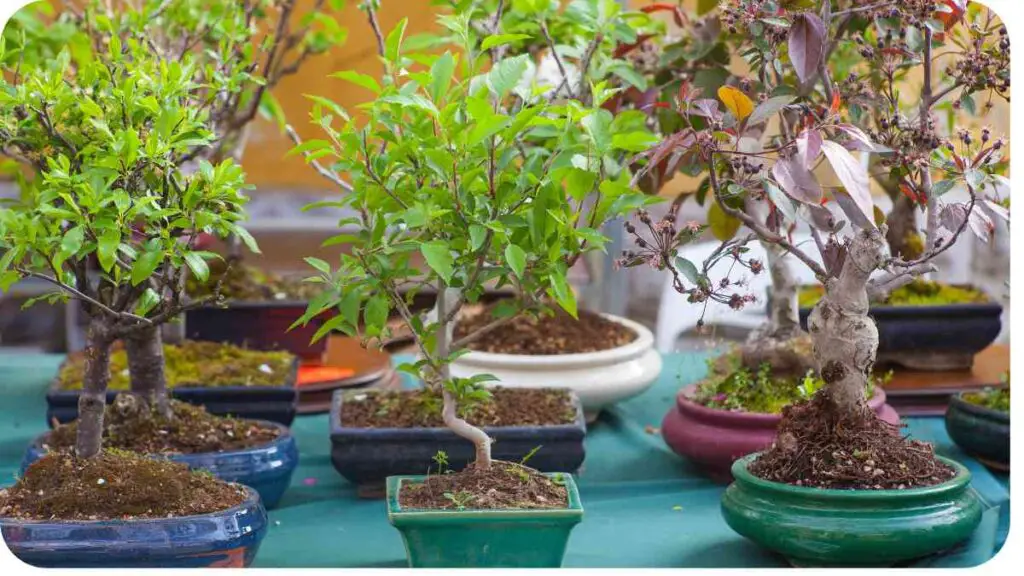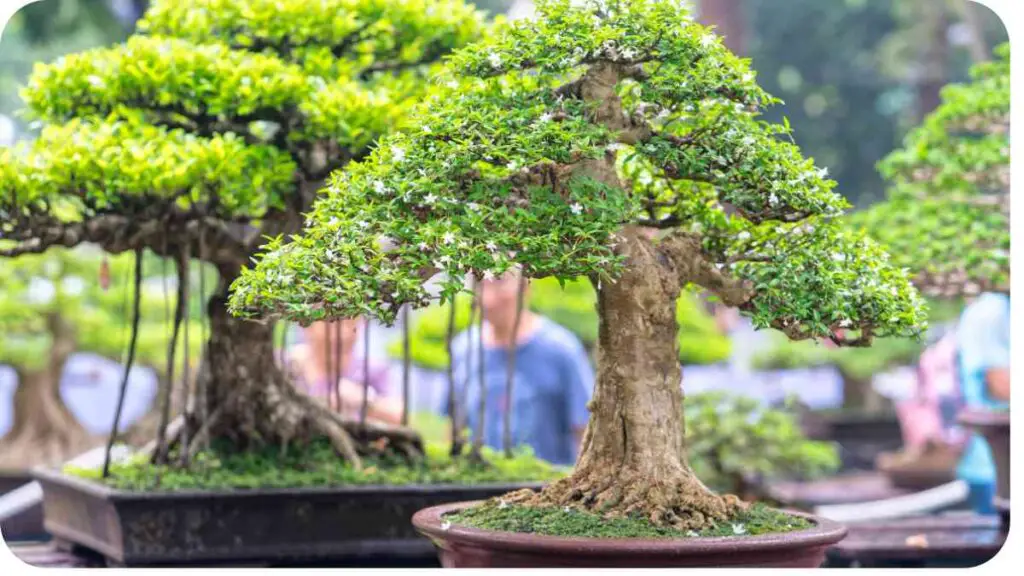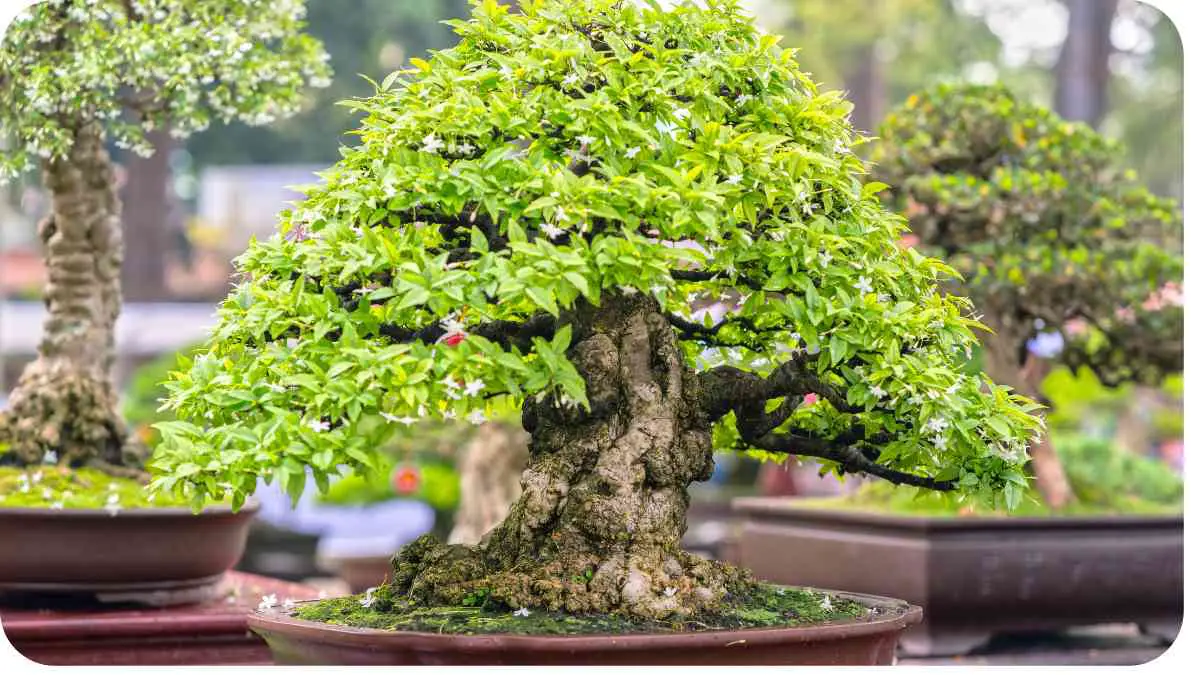Bonsai, the ancient Japanese art form of cultivating miniature trees, has captivated enthusiasts around the world for centuries. From its origins in China to its refinement in Japan, bonsai has evolved into a deeply meditative and artistic practice.
In this article, we’ll delve into the fundamentals of bonsai cultivation, exploring techniques, tips, and tricks to help you master the art of miniaturizing mighty maples.
| Key Takeaways |
|---|
| 1. Start with the right tree species for your climate and skill level. |
| 2. Use well-draining bonsai soil to prevent root rot. |
| 3. Choose a pot that provides adequate space for root development. |
| 4. Learn proper pruning and wiring techniques for shaping your bonsai. |
| 5. Maintain a regular watering and fertilizing schedule to keep your bonsai healthy. |
| 6. Stay vigilant against pests and diseases through regular inspection and treatment. |
| 7. Display your bonsai with care, enhancing its beauty and showcasing your craftsmanship. |
Table: Popular Bonsai Tree Species
| Species | Characteristics |
|---|---|
| Japanese Maple | Elegant foliage, vibrant colors |
| Juniper | Hardy, adaptable, easy to shape |
| Pine | Symbolizes longevity and strength |
| Ficus | Indoor-friendly, glossy leaves |
| Elm | Small leaves, beautiful bark |
2. Choosing the Right Tree Species
Selecting the appropriate tree species is crucial for bonsai success. Each species has unique characteristics that influence its suitability for bonsai cultivation. Consider factors such as climate, available space, and your level of expertise when choosing a tree.
Delve into the meticulous process of bonsai cultivation and discover the intricate techniques behind transforming ordinary trees into captivating miniature wonders. Explore the cultivation process and unlock the secrets of bonsai mastery.
Table: Climate Suitability for Common Bonsai Species
| Species | Ideal Climate | Considerations |
|---|---|---|
| Japanese Maple | Temperate regions | Requires protection from harsh sun |
| Juniper | Varied climates | Resistant to cold, drought, and wind |
| Pine | Temperate to cold | Requires well-drained soil |
| Ficus | Tropical regions | Prone to cold damage below 50°F (10°C) |
| Elm | Temperate regions | Susceptible to Dutch Elm Disease |
When selecting a tree, assess its trunk, branches, and roots for desirable characteristics. Look for a well-developed trunk with taper, balanced branches, and a radial root system suitable for container growth.
3. Understanding Bonsai Soil

Bonsai soil differs from traditional gardening soil, as it requires excellent drainage and aeration to support the health of miniature trees. Understanding the composition of bonsai soil is essential for maintaining proper moisture levels and preventing root rot.
Ever wondered why prolonged water exposure wrinkles our fingers and toes? Unravel the intriguing science behind this phenomenon and explore the reasons for wrinkling in waterlogged conditions.
Table: Components of Bonsai Soil Mix
| Component | Purpose | Examples |
|---|---|---|
| Akadama | Provides structure and drainage | Fired clay granules |
| Pumice | Improves aeration | Lightweight volcanic rock |
| Lava rock | Enhances drainage | Porous rock material |
| Organic matter | Adds nutrients | Pine bark, compost |
| Perlite | Increases drainage | Lightweight volcanic glass |
A well-balanced bonsai soil mix typically consists of a combination of these components, tailored to the specific needs of the tree species and local climate conditions.
4. Pot Selection and Sizing
Choosing the right pot for your bonsai is not just about aesthetics; it directly impacts the tree’s health and growth. Proper pot selection and sizing are essential for providing adequate space for root development and maintaining the tree’s overall balance.
Table: Bonsai Pot Sizes Based on Tree Height
| Tree Height (cm) | Recommended Pot Size (cm) |
|---|---|
| Up to 15 | 10-15 |
| 15-30 | 15-20 |
| 30-45 | 20-25 |
| 45-60 | 25-30 |
| 60-90 | 30-40 |
| 90+ | 40+ |
When selecting a pot, consider both the depth and width to accommodate the tree’s root system. A shallow pot encourages shallow root growth, suitable for trees with compact root systems like junipers, while deeper pots are suitable for species with deeper roots like maples.
Learn the art of pruning and unleash the potential for robust growth in your plants. Discover the secrets to unlocking growth through precise pruning techniques and nurture flourishing foliage in your garden.
5. Pruning Techniques
Pruning is one of the most critical techniques in bonsai cultivation, shaping the tree’s growth and enhancing its aesthetic appeal. Understanding when and how to prune effectively is essential for maintaining the tree’s health and promoting its desired form.
Table: Types of Bonsai Pruning
| Type | Purpose | Tools Required |
|---|---|---|
| Maintenance Pruning | Regular trimming to maintain shape | Pruning shears |
| Structural Pruning | Shaping branches and promoting taper | Concave cutters |
| Pinching | Stimulating growth and refining foliage | Fingers or scissors |
| Root Pruning | Controlling root growth and maintaining pot size | Root scissors |
Each type of pruning serves a specific purpose in bonsai cultivation. Regular maintenance pruning helps maintain the tree’s silhouette, while structural pruning shapes the overall form and encourages taper in branches.
6. Wiring and Shaping
Wiring is a fundamental technique in bonsai that allows artists to sculpt the tree’s branches and trunk into the desired shape. By wrapping aluminum or copper wire around branches and gently bending them, practitioners can create elegant and natural-looking curves, bends, and angles.
Table: Bonsai Wiring Guidelines
| Wire Thickness | Ideal for | Usage Duration |
|---|---|---|
| 1.0mm – 1.5mm | Medium-sized branches | 3-6 months |
| 2.0mm – 3.0mm | Thick branches and trunk | 6-12 months |
| 3.0mm – 5.0mm | Large branches and trunk | 12-18 months |
When wiring, ensure the wire is wrapped loosely around the branch to avoid damaging the bark. Monitor the tree regularly and remove the wire once the desired shape has been achieved to prevent wire scarring.
Explore the enduring charm of bonsai trees, thriving for centuries in their tiny pots. Uncover the centuries-old secrets behind their longevity and delve into the unique care practices that sustain their miniature magnificence.
7. Watering Essentials
Proper watering is crucial for the health and vitality of bonsai trees. Maintaining the right moisture levels ensures that the tree receives essential nutrients and hydration without risking root rot or dehydration. Understanding the principles of watering is essential for bonsai enthusiasts to keep their trees thriving.
Table: Bonsai Watering Guidelines
| Season | Frequency | Watering Technique |
|---|---|---|
| Spring | Daily to every 2 days | Water thoroughly until water drains |
| Summer | Daily | Monitor soil moisture, avoid overwatering |
| Autumn | Every 2-3 days | Adjust frequency as temperatures drop |
| Winter | Weekly | Water sparingly, prevent freezing |
During hot and dry weather, bonsai trees may require more frequent watering to prevent dehydration. Conversely, during cooler months, reduce watering frequency to avoid waterlogged soil.
8. Fertilizing Your Bonsai
Fertilization plays a vital role in supplying bonsai trees with essential nutrients for growth and development. Proper fertilization ensures that the tree maintains vigor and vitality, promoting lush foliage and vibrant blooms. Understanding the principles of fertilizing is crucial for bonsai enthusiasts to provide their trees with the nutrients they need to thrive.
Table: Bonsai Fertilization Schedule
| Season | Frequency | Fertilizer Type |
|---|---|---|
| Spring | Every 2 weeks | Balanced fertilizer (NPK 10-10-10) |
| Summer | Every 4 weeks | High-nitrogen fertilizer (NPK 20-10-10) |
| Autumn | Every 6 weeks | Balanced fertilizer (NPK 10-10-10) |
| Winter | No fertilization | Allow tree to rest |
Choose a fertilizer with a balanced NPK ratio suitable for bonsai trees. Avoid over-fertilizing, as it can lead to nutrient imbalances and root burn. During the winter months, withhold fertilizer to allow the tree to enter a period of dormancy.
9. Repotting Bonsai
Repotting is a critical aspect of bonsai maintenance that ensures the health and vitality of the tree. Over time, bonsai trees outgrow their pots, deplete the soil of nutrients, and become root-bound, necessitating repotting. Understanding when and how to repot your bonsai is essential for promoting healthy growth and longevity.
Have you ever wondered why our skin wrinkles after prolonged exposure to water? Understand the science behind pruney digits and explore the fascinating physiological changes that occur, shedding light on this common phenomenon.
Table: Bonsai Repotting Schedule
| Age of Bonsai | Frequency | Signs It’s Time to Repot |
|---|---|---|
| Young (1-3 years) | Annually | Roots circling the pot, reduced growth |
| Mature (3-5 years) | Every 2-3 years | Soil compacted, water draining slowly |
| Established (5+ years) | Every 3-5 years | Noticeable decline in health, root-bound |
Repotting should typically be done during the tree’s dormant period in early spring or late winter. When repotting, carefully remove the tree from its pot, trim the roots, and repot it into fresh bonsai soil. Trim back any overgrown branches to maintain balance and reduce stress on the tree.
10. Bonsai Pests and Diseases

Like all plants, bonsai trees are susceptible to pests and diseases that can compromise their health and vitality. Identifying common pests and diseases early and taking prompt action is crucial for preventing damage and preserving the beauty of your bonsai collection. Understanding how to recognize and treat these issues is essential for maintaining thriving bonsai trees.
Table: Common Bonsai Pests and Diseases
| Pest/Disease | Symptoms | Treatment |
|---|---|---|
| Aphids | Sticky residue on leaves, stunted growth | Insecticidal soap, neem oil |
| Spider Mites | Fine webbing, yellowing leaves | Spraying with water, insecticidal soap |
| Scale Insects | Brown or black bumps on stems and leaves | Rubbing alcohol, insecticidal soap |
| Root Rot | Yellowing leaves, wilting, mushy roots | Improve drainage, repotting, fungicide |
| Powdery Mildew | White powdery spots on leaves | Fungicidal spray, improve air circulation |
Regularly inspect your bonsai trees for signs of pests or diseases, especially during periods of rapid growth or stress. Quarantine affected trees to prevent the spread of pests and treat them promptly with appropriate methods to restore their health.
11. Bonsai Display and Maintenance
Displaying bonsai is an art form in itself, enhancing the beauty and tranquility of indoor and outdoor spaces. Proper maintenance and presentation are essential for showcasing your bonsai collection effectively and ensuring the trees’ health and longevity. Understanding how to create visually appealing displays and maintain your bonsai trees is crucial for cultivating a captivating bonsai garden.
Table: Bonsai Display Tips
| Display Element | Purpose | Tips |
|---|---|---|
| Bonsai Stand | Elevates tree for better visibility | Choose stands that complement the tree’s style and size |
| Accent Plants | Enhances composition and adds interest | Select plants with contrasting foliage or flowers |
| Decorative Rocks | Adds visual interest and stability | Arrange rocks to mimic natural landscapes |
| Display Lighting | Highlights tree and adds ambiance | Use adjustable LED lights for optimal positioning |
Regular maintenance tasks include pruning, wiring, and repotting as needed to maintain the tree’s shape and health. Keep an eye on watering and fertilization schedules, adjusting as necessary based on seasonal changes and the tree’s growth patterns.
12. Common Mistakes to Avoid
While bonsai cultivation can be deeply rewarding, it’s also easy to make mistakes that can hinder your tree’s growth and health. Understanding common pitfalls and avoiding them is essential for success in bonsai cultivation. By learning from others’ mistakes and practicing patience and attention to detail, you can overcome obstacles and cultivate thriving bonsai trees.
Table: Common Bonsai Mistakes
| Mistake | Description | Prevention |
|---|---|---|
| Overwatering | Leads to root rot and fungal diseases | Monitor soil moisture, water only when necessary |
| Underwatering | Results in dehydration and wilting | Establish a regular watering schedule, check soil moisture regularly |
| Improper Pruning | Damages branches and disrupts tree balance | Educate yourself on proper pruning techniques, start with light pruning |
| Incorrect Wiring | Causes scars and damages tree structure | Practice with softer wires and seek guidance from experienced growers |
| Neglecting Pests | Allows pests to infest and damage trees | Inspect trees regularly for signs of pests, treat promptly if detected |
Avoiding these common mistakes requires diligence, patience, and a willingness to learn from both successes and failures. With time and experience, you’ll develop the skills and intuition necessary to nurture healthy and beautiful bonsai trees.
13. Famous Bonsai Artists and Their Work
Throughout history, numerous bonsai artists have left a lasting legacy through their exceptional skill and creativity in the art of bonsai cultivation. Their masterpieces inspire awe and admiration, showcasing the beauty and potential of miniature trees. Learning about these renowned artists and their work can provide valuable insights and inspiration for bonsai enthusiasts.
Table: Famous Bonsai Artists and Their Contributions
| Artist | Contribution | Notable Works |
|---|---|---|
| Masahiko Kimura | Innovator known for bold styling | “Goshin” (The Guardian of the Spirit) |
| John Naka | Pioneer in bonsai education | “Goshin” (The Guardian of the Spirit) |
| Saburo Kato | Promoter of naturalistic bonsai styles | “Nanboku-tei” (Southern Alps) |
| Yuji Yoshimura | Renowned for teaching bonsai in the West | “Ten Best Bonsai” series |
| Walter Pall | Advocate for naturalistic bonsai styles | Various masterpieces |
Studying the works of these masters offers valuable lessons in bonsai aesthetics, techniques, and philosophy. Their dedication and passion for the art have left an indelible mark on the bonsai community, inspiring generations of enthusiasts worldwide.
14. Conclusion
Mastering the art of bonsai cultivation is a deeply rewarding journey that requires patience, dedication, and a keen eye for detail. By understanding the fundamentals of bonsai care, from selecting the right tree species to creating captivating displays, enthusiasts can cultivate thriving miniature trees that evoke the beauty and serenity of nature.
In this article, we’ve explored essential bonsai basics, from soil composition and watering techniques to pruning and wiring methods. We’ve also delved into common mistakes to avoid and celebrated the work of famous bonsai artists who have shaped the art form with their creativity and innovation.
As you embark on your bonsai journey, remember that each tree tells a unique story, reflecting the careful attention and nurturing it receives. By honing your skills and embracing the principles of bonsai cultivation, you can create stunning works of living art that bring joy and inspiration for years to come.
Further Reading
- Bonsai Empire Podcast: Explore insightful discussions and expert interviews on all things bonsai in this engaging podcast series.
- A Comprehensive Guide to Bonsai Trees: Dive deep into the world of bonsai with this comprehensive guide covering everything from basic techniques to advanced styling tips.
- Maple Sextet: Basic Styling of Chinese Maple Bonsai Trees: Learn the art of styling Chinese maple bonsai trees with this informative blog post, featuring step-by-step instructions and expert insights.
FAQs
Can bonsai trees be grown indoors?
Yes, certain species of bonsai trees, such as ficus and jade, can thrive indoors with proper care and lighting.
How often should I water my bonsai tree?
The frequency of watering depends on factors such as tree species, pot size, and environmental conditions. As a general rule, check the soil moisture regularly and water when the top inch of soil feels dry to the touch.
Do bonsai trees require special soil?
Yes, bonsai trees require well-draining soil that promotes good root health. Specialized bonsai soil mixes, composed of components like akadama, pumice, and lava rock, are commonly used to ensure adequate drainage and aeration.
When is the best time to repot a bonsai tree?
The best time to repot a bonsai tree is typically during its dormant period in early spring or late winter. This allows the tree to recover from the shock of repotting before entering a period of active growth.
How can I prevent pests and diseases in my bonsai tree?
Regularly inspect your bonsai tree for signs of pests or diseases, such as yellowing leaves or unusual spots. Practice good hygiene by removing dead leaves and debris from the soil surface, and consider using preventive measures such as neem oil or insecticidal soap.

For 15 years, Hellen James has worked in the gardening industry as an expert and landscape designer. During her career, she has worked for a variety of businesses that specialize in landscaping and gardening from small firms to large corporations.

